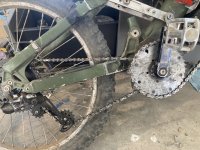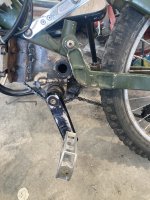DingusMcGee
10 kW
Squat motion refers to the unweighting, sag and compression of the rear triangle of an FSR bike during startup or just accelerations. This unweighting feels like the rear tire is being lifted off the ground and such forces can lead to breaking traction at startup — a no, no. The position of the rear wheel chain in relation to the hinge pin of the lower stays is the main determining factor for the likely hood of having squat at startup. If the chain line at start up ( sitting on the bike) is above the hinge pin, you most likely will experience sag during any hard accelerations. The overall potential of squat action changes through out the motion of the triangle.
There are some simple changes to the rear suspension configuration that may reduce (or eliminate ?) sag at startup. More air pressure in the rear shock or cranking on more spring tension to the shock certainly can lessen sag. If you have a 2 chain reduction and the double sprockets are on the pedal axle, then a smaller sprocket for the cog connecting to the rear wheel can move the chain line down more from the lower hinge pin of the rear triangle.
Sometimes these two simple changes will not reduce squat sufficiently and the bike continues to break traction on hard accelerations or when the front tire hits a headwall. There is a fix that can be done a couple of ways. If your bike has a steel frame you can move the BB shell down — cutting and welding. If your bike has an alum frame, a new location for a BB shell can be added to your steel motor frame plates. This location must increase the distance the BB axle is below the hinge pin location compared to the the distance of the OEM position.
I had downhill Brodie Thumster bike that even at the mildest accelerations would squat and break traction. The simple changes I suggest made no significant change in traction breaking. The fix of lowering the BB shell location was an obvious success. In fact the bike has too much rise. Upon acceleration the rear of the bike seat rises noticeably at the rear, thus weighting the rear tire. I currently am testing larger sprockets on the BB axle sprockets to the rear. This trial and error testing is simply the tuning phase as these changes make an improvement towards lessening the rise.
Here are some pics. The OEM BB shell position was higher than a typical bike has, so this drop still leaves about 12” clearance from the ground.
 showing the new BB location:
showing the new BB location:
There are some simple changes to the rear suspension configuration that may reduce (or eliminate ?) sag at startup. More air pressure in the rear shock or cranking on more spring tension to the shock certainly can lessen sag. If you have a 2 chain reduction and the double sprockets are on the pedal axle, then a smaller sprocket for the cog connecting to the rear wheel can move the chain line down more from the lower hinge pin of the rear triangle.
Sometimes these two simple changes will not reduce squat sufficiently and the bike continues to break traction on hard accelerations or when the front tire hits a headwall. There is a fix that can be done a couple of ways. If your bike has a steel frame you can move the BB shell down — cutting and welding. If your bike has an alum frame, a new location for a BB shell can be added to your steel motor frame plates. This location must increase the distance the BB axle is below the hinge pin location compared to the the distance of the OEM position.
I had downhill Brodie Thumster bike that even at the mildest accelerations would squat and break traction. The simple changes I suggest made no significant change in traction breaking. The fix of lowering the BB shell location was an obvious success. In fact the bike has too much rise. Upon acceleration the rear of the bike seat rises noticeably at the rear, thus weighting the rear tire. I currently am testing larger sprockets on the BB axle sprockets to the rear. This trial and error testing is simply the tuning phase as these changes make an improvement towards lessening the rise.
Here are some pics. The OEM BB shell position was higher than a typical bike has, so this drop still leaves about 12” clearance from the ground.

 showing the new BB location:
showing the new BB location:
Last edited:





